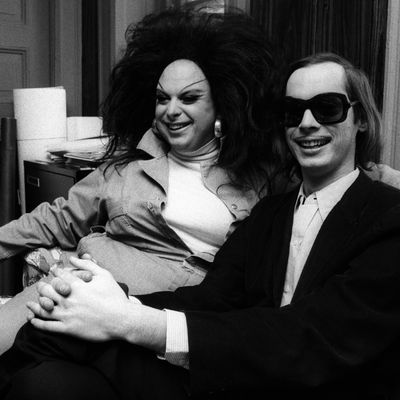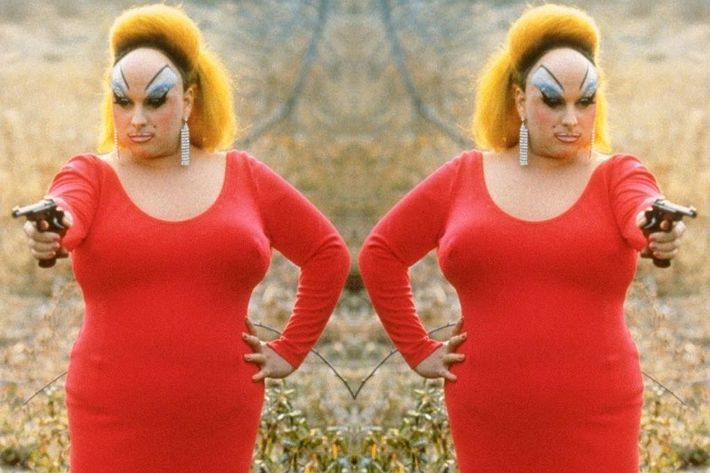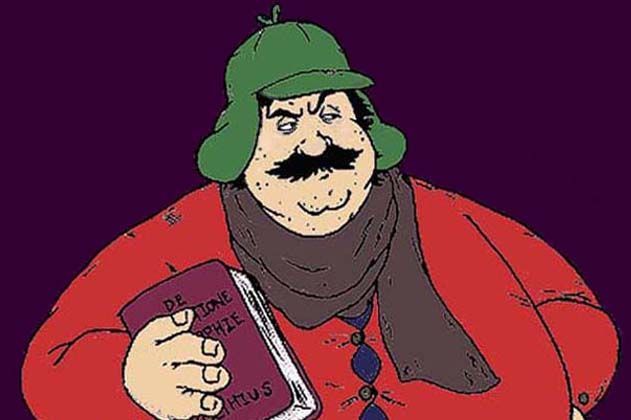
John Waters, Baltimore’s infamous Pope of Trash and the auteur behind such rude comedies as Pink Flamingos (1972), Female Trouble (1974), and Desperate Living (1977), has not released a movie since 2004’s head-injury sex farce A Dirty Shame with Tracey Ullman and Johnny Knoxville. Waters has had gaps in his directing filmography before, including a seven-year drought between Polyester (1981) and Hairspray (1988) during the Reagan years, but nothing like this. The closest John Waters has come to directing a feature film since A Dirty Shame is Kiddie Flamingos: A John Waters Table Read, a sanitized, all-kid version of Pink Flamingos, and that only played as part of his Beverly Hills John exhibit at New York’s Marianne Boesky Gallery in early 2015. And since it’s just a staged reading of a 43-year-old script, with bewigged children seated, Last Supper-style, behind a table, it barely qualifies as Waters’ “new movie.”
In fact, Waters has spent the last decade concentrating on his numerous other, more profitable careers: conceptual artist, public speaker, and author. His side businesses, at least, are flourishing. Those endeavors have kept the erstwhile Prince of Puke in the public eye, ensuring that he still has plenty to talk about during his many talk show appearances. In fact, Waters recently signed a deal with Farrar, Straus and Giroux to do two more books, including another essay collection and his first novel, to be titled Liarmouth. And, of course, he continues to be a fixture as a “talking head” in pop culture documentaries. But new feature films have not been forthcoming.
“Product shortage,” Waters once boasted in an essay called “How Not to Make a Movie,” “is what I’m all about.”
With movies becoming prohibitively expensive and just a few major studios maintaining their chokehold on exhibition and distribution, it is conceivable that John Waters may never direct another motion picture. There are no such projects pending on his IMDb page. Now might be a good time to look back at the movies Waters didn’t make, the projects he either could not complete or which he could never even start making, usually due to financing issues. As these projects prove, Waters has as wild and intriguing an “alternate universe” filmography as just about any director this side of Terry Gilliam or Alejandro Jodorowsky.
Let us journey, then, into uncharted Waters.
Dorothy, the Kansas City Pothead (1968)
Dorothy, the Kansas City Pothead (1968)
The Wizard of Oz (1939) was one of John Waters’ biggest cinematic influences, and Dorothy, the Kansas City Pothead was to be his THC-infused homage to it. At that point, Waters had only made the experimental films Hag in a Black Leather Jacket (1964) and Roman Candles (1966) and had yet to tackle a narrative feature. But he was already an expert at capturing the attention of the local media, and Candles had nabbed a gratifying amount of ink from the suitably horrified Baltimore press. Waters and his gang of cinematic miscreants, dubbed the Dreamlanders, had momentum on their side when they approached their next project. As Waters writes in his 1981 memoir, Shock Value:
I tried to make my next film, Dorothy, the Kansas City Pothead, but it never really got off the ground. [Waters’ friend and casting director] Pat Moran played Dorothy, and Maelcum [Soul] was the Witch, but I soon learned that it was impossible to make a lip-sync sound film with only a camera and tape recorder. I sent out press releases anyway and got a big article in the Baltimore Sunpapers headlined, ‘The Wizard of Oz Goes to Pot.’ The reporter never suspected that there wasn’t even any film in my camera when he covered ‘the making of the film.’
Waters further reflected on Pothead in Steve Yeager’s excellent 1998 documentary, Divine Trash:
Dorothy, the Kansas City Pothead was supposed to be, obviously, The Wizard of Oz goes to pot. It’s the only movie I ever started that was abandoned. Pat Moran played Dorothy. George Figgs played the Scarecrow. We only shot, I think, a day or two of it.
What survives of the film is about a minute of silent color footage featuring Moran, who in 2015 won an Emmy for her casting work on Veep, donning pigtails and a gingham dress as Dorothy Gale, skipping merrily down a country lane and dragging an absurdly fake-looking, inanimate Toto behind her. George Figgs, who would go on to play Jesus Christ in Waters’ Multiple Maniacs (1970), appears for a few seconds in an impressive-enough scarecrow costume. Neither actor really does anything, though.
Flamingos Forever (early-to-mid-1980s)

Flamingos Forever (early-to-mid-1980s)
Arguably the most famous “what if” in John Waters’ filmography is this absurdly baroque sequel to Pink Flamingos. Even after seemingly abandoning the world of “midnight movies” in favor of the multiplexes with the relatively more mainstream Polyester, John tried to return to his roots with another self-styled cult item, only to find that he really and truly could not go home again.
In his 1988 book, Trash Trio: Three Screenplays, Waters writes that producers balked at even his modest $600,000 budget for the film, calling the screenplay “atrocious.” Only Troma Films showed real interest in backing the sequel, but Waters had no confidence in the micro-studio’s “postproduction facilities.” Divine, meanwhile, was nervous about the demanding physical stunts, which included an underwater pie-eating sequence. But it was the 1984 death of irreplaceable, snaggle-toothed character actress Edith Massey that was, in Waters’ words, “the first nail in the coffin of Flamingos Forever.” Waters reflected on the death of the project in a March 1985 interview with Jack Stevenson: “When Edie died, I thought it couldn’t be a movie. And also, we didn’t have the money. It was really hard to get money for that movie because it was so much crazier than Polyester.” After mentioning that he struggled for two years to get the financing for the movie (“a big hassle”), he sadly noted that Massey’s death made his efforts irrelevant. “I don’t think audiences would go for a fake Edie.”
For what it’s worth, Forever is basically a beat-for-beat remake of Pink Flamingos, only with the volume cranked up and the references updated to the ‘80s. After 15 years on the road, Divine returns to Baltimore with her crazy family in tow: hillbilly son and incestuous husband Crackers II, mentally-addled adoptive mother Miss Edie (now going through a “communist” phase), voyeuristic “traveling companion” Cotton II, and effeminate, cross-dressing offspring Duane, the result of her unholy union with Crackers. As in the first movie, Divine soon finds herself at war with another contender for the title of “the Filthiest Person Alive.” This time, it’s child kidnapper Vera Venninger, sister of the late Peggy Gravel, the villainess from the first film. Supporting Divine in this conflagration are her loyal cult followers, who refer to themselves as Divinities. Jokes about necrophilia, female-on-male rape, heroin addiction, and pornography abound, and the film culminates with Divine and her loved ones riding a giant flying turd, a la Thief of Baghdad, to Cape Canaveral.
If produced, Waters’ screenplay for Flamingos Forever would have provided juicy roles to his band of regulars: Divine, Mary Vivian Pearce, Mink Stole (who, according to Jack Stevenson, was “insanely enthusiastic” about the film), Jean Hill, and Edith Massey. In a 1992 interview with John G. Ives, Waters revealed that the characters of Cotton and Crackers had Roman numerals attached to their names “in case we couldn’t get them. I knew Bonnie [Mary Vivian Pearce] was willing but Danny [Mills, the original Crackers] probably wouldn’t have done it.” Speaking of casting, Waters apparently had a few “guest stars” in mind for this never-to-be sequel. Certain characters are described as strongly resembling such bad-taste icons as Charo, Liberace, and Chesty Morgan, the last of whom would have played Divine’s biological mother and bared her “nozzles of life” for the press. “I had all sorts of bizarre casting ideas in mind,” Waters wistfully wrote in Trash Trio.
Though Flamingos Forever never went before the cameras, that didn’t stop Waters from plundering the “stillborn” sequel for ideas for his future movies. The character names Wilbur, Tracy, and Inez were ported over to his next feature, Hairspray. Nearly 20 years later, A Dirty Shame finally allowed Waters to do a scene built around the “Hokey Pokey.” Shame also had a Chesty Morgan-inspired character, though the role was played by Selma Blair. And Cecil B. Demented (2000) wound up as Waters’ repository for jokes about mindless cult worship.
A Confederacy of Dunces (mid-1980s)

A Confederacy of Dunces (mid-1980s)
Flamingos Forever was not the only unprofitable cinematic dream John Waters chased in the 1980s. As he described in his 1986 essay collection Crackpot: The Obsessions of John Waters, he also tried without success to mount a film adaptation of John Kennedy Toole’s posthumously published, satirical novel, A Confederacy of Dunces. In fact, his fruitless pursuit of Forever and Confederacy is largely what kept Waters off movie screens in the ‘80s. In Confederacy’s lead character of Ignatius J. Reilly, a slovenly, irritable New Orleans intellectual forced to enter the working world to pay for the damages from his drunken mother’s car accident, John Waters saw a potential role for Divine. The actor was always looking for parts that didn’t require him to dress in elaborate drag, and Ignatius, an ample-bodied half-slob/half-snob with a penchant for self-righteous tirades, could have provided him with just that. And, though he was from Baltimore, Waters was familiar with New Orleans, having lived there for a time in the early ‘70s. Unfortunately, Waters’ infamous past may have doomed his chances of directing the film, as he explained in Crackpot:
My first ‘pitching experience’ in Hollywood came when I tried to get the job of director of A Confederacy of Dunces, a book I loved and the only project I’d ever been interested in that I didn’t write. The meeting seemed to go OK. The producer listened politely to my ideas, but I never heard from him again. He never even gave me the official ‘no.’ It wasn’t until about a year later that I figured out why. I had left this executive a copy of my book which included a photo of myself and a mass murderer I had befriended in my never-ending interest in abnormal psychology. Unfortunately, he had killed one of the producer’s best friends. I felt really awful. And, natch, I didn’t get the job. It might have been the single most disastrous ‘meeting’ to ever take place in Hollywood, but then I guess that all directors have their stories.
By 1992, when he talked to John G. Ives, Waters had come to peace with the fact that A Confederacy of Dunces was never going to happen. At least not for him. Sounding a bit like Aesop’s fox, the one who gave up on those unreachable grapes, he explained:
The other thing is, Confederacy of Dunces, I don’t want to do that anymore, because when a book is so revered by a specific audience, the movie could never be as good as the audience wants it to be. The old maxim may be true: ‘Good books make bad movies and bad books make good movies.’
Waters could at least take comfort in the fact that fellow filmmakers Steven Soderbergh, Harold Ramis, and David Gordon Green also tried without success to bring Confederacy to the screen.
Glamourpuss, both versions (early-to-mid-1990s)
Glamourpuss, both versions (early-to-mid-1990s)
One of the major selling points of John G. Ives’ 1992 book, American Originals: John Waters, was that it included, according to the inside flap, “a discussion of his upcoming film Glamourpuss.” As Ives’ discussion with Waters revealed, however, there were actually two different Glamourpusses, and neither one made it to the silver screen.
Waters explained to Ives that the first Glamourpuss was “about a white boy who wanted to be black and teamed up with a black fag hag, and together they fought a skinhead invasion of their community.” In a line he would repeat in interviews for years, he described this version of the film as “Mahogany meets The Battle of Algiers” and said it was inspired by a Newsweek article he’d written “about how kids should rebel, about being black if you’re white.” According to Waters, every studio executive said no to this film, but Dawn Steel at Disney was at least amused by Waters’ gall at pitching a skinhead movie at the House of Mouse. “They all said it was really funny,” Waters remembered, “but that it was too weird.”
The second, ostensibly more commercial version of Glamourpuss was actually Waters’ original idea for the project all along, the one he’d had since the making of Cry-Baby (1990). He just got sidetracked with his odd, unmarketable “skinhead” idea and wrote that script instead. After his experience pitching that Glamourpuss without success, however, he went back to Plan A: the story of “a Hollywood movie star who comes to Baltimore and falls in love with a truck driver.” According to Ives, Paramount picked up this version of Glamourpuss for development, then put it in turnaround.
By 1994, when Waters spoke to The Advocate’s Lance Loud, the director had moved on to Serial Mom; the abandoned Glamourpuss was just another funny anecdote from his past. The closest the film came to seeing the light of day – and it isn’t close – is that its alternate title (Waters calls it a “back-up”), Raving Beauty, became the name of the movie-within-a-movie supposedly being filmed in Cecil B. Demented. Although Cecil also centered around a Hollywood actress who comes to Baltimore and has her life interrupted, the truck driver love story was long gone.
Fruitcake (2007)

Fruitcake (2007)
The last truly encouraging news John Waters’ fans received concerning a new movie arrived in April 2007, when Jeff Jackson’s excellent Waters fan site Dreamland News reported that the director had mentioned “a children’s Christmas adventure called Fruitcake,” during his appearance at a librarian convention. Apparently, after A Dirty Shame was slapped with the dreaded NC-17 rating in 2004, Waters wanted to go completely in the opposite direction and make his version of a family film. His vision for the project, as he told Interview, was “Little Rascals on acid.”
In December 2007, Jackson told fans that Fruitcake was “scheduled to start shooting this winter with Johnny Knoxville and a cast of children.” In May 2008, The Hollywood Reporter declared that Knoxville was “attached” to the project, as was indie princess Parker Posey. “The plot is officially under wraps but is said to center on the title character, a boy named after his favorite dessert. He runs away from home during the holidays after he and his parents are caught shoplifting meat, then meets up with a runaway girl raised by two gay men and searching for her birth mother.” After failing to secure a deal with his usual distributor, New Line Cinema, Waters took Fruitcake to This Is That Prods. and Killer Films, the companies behind A Dirty Shame. ThinkFilm also expressed some interest.
Filming was supposed to begin in November 2008, but the project was declared dead in January 2009, as reported by the World Entertainment News Network. Again, financing proved elusive. Waters blamed the then-slumping economy but kept his trademark sense of humor about the fickle nature of the movie industry. “I can’t get it made,” he said. “It’s a children’s movie. I thought it would do well, but it’s not. I saw The Reader. Here’s a movie that asked you to root for a pedophile Nazi guard. That got made.” But, even after Hairspray conquered Broadway, the world wasn’t ready for a John Waters Christmas family film.
At that time, Waters speculated that he would have to return to his first job and become a puppeteer again. The subsequent seven years since the death of Fruitcake have proven that John was needlessly worried about his future. Live performances, new books, and gallery exhibits have kept him very busy since then. But, still in all, a valedictory movie would be nice. Back in 1992, Pat Moran told John G. Ives that she wanted to see Waters “do a really serious movie, probably a psychodrama. Something like Silence of the Lambs, because that one scared people the most.” Hey, there’s still time.




